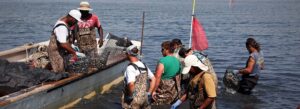By some estimates, sandbar shark populations were on the rise — but by other estimates, sandbar sharks were declining. They couldn’t all be correct. The scientists tasked with determining the overall trend of sandbar shark populations were not in agreement about how to deal with the contradictory data.
Understanding shark abundance is a critical part of stock assessments, the formal scientific evaluation that determines whether a shark species is growing or shrinking. Then, in a separate process, shark managers use the information from the assessments to make decisions for each of the 40-plus shark species managed by the National Marine Fisheries Service (NMFS).
Although there wasn’t a good way to deal with the discrepancy in the data, there was no question about its cause: conflicting abundance data. Researchers use indices of abundance from scientific surveys and patterns in commercial catches to estimate how many sharks are in the ocean. But sharks can migrate thousands of miles in a single year, and their movement can change with water temperatures, food availability, and age of the shark.
No single survey can capture the full picture of shark migration throughout the year. Instead, assessment scientists piece together snapshots through smaller scientific surveys. Since sharks are more spread out than other types of fish, a survey might not catch any sharks by chance some years. This can create confusion about the true abundance of sandbar sharks, according to Cassidy Peterson, a management strategy evaluation specialist at the NMFS Southeast Fisheries Science Center.
Collectively, these different surveys give a rough idea of how many sharks are in the water for stock assessments. In the case of the 2017 sandbar shark assessment, scientists pieced together 11 indices of abundance, some of which conflicted with one another.
“Whether the population looked like it had increased over time or decreased really depended on which survey index you looked at,” Peterson said. “This not only hinders our understanding of the resource, but this is the same information we’re putting into a stock assessment model. It’s going to confuse the model in the same way it’s confusing us.”
During the 2017 stock assessment, the scientists ultimately dealt with the conflicting data by entering each of the 11 indices separately into the stock assessment model. As a backup estimate, the researchers also created best-case and worst-case scenarios by using only the decreasing surveys in one trial, and then using only the increasing surveys in another trial.
These two scenarios created “bookend” estimates, with true shark abundance likely falling somewhere in between. Still, the conflicting surveys still muddied the water and created uncertainty about the status of the sandbar shark.
“We go through a tremendous amount of effort to try and standardize surveys through statistical techniques, but even then, we often encounter some issues,” Peterson said. “There has been this idea that we really need to figure out a way to figure out the trend in the resource before moving forward with stock assessments.”
Since shark migration and limited surveys make data conflicts unavoidable, Peterson tested a new method to reconcile these conflicts as part of her NMFS-Sea Grant Fellowship and Ph.D. research at the Virginia Institute of Marine Science. The mathematical approach, called dynamic factor analysis, combines the trends from the separate indices to create a single, simplified trend in abundance.
This method consolidates the different sources of abundance information by identifying common patterns over time and the causes of those patterns. The unified trend can then be put into the stock assessment model to improve the quality of the results.
Simulating sharks to test assessment methods
Peterson confirmed that dynamic factor analysis would work well for real-world shark assessments by using a simulation of the shark fishery. The simulation allows researchers to know the true abundance of sharks, and test whether the trend from dynamic factor analysis is accurate.
“You simulate the shark population, fish it, survey it to generate those conflicting indices of abundance, use a dynamic factor analysis to reconcile those conflicting trends, and then compare that to the simulated truth,” Peterson said.
She tested the method for both sandbar sharks and Atlantic sharpnose sharks. Peterson found that dynamic factor analysis was an effective tool to estimate shark abundance when some indices created conflicting trends, or when there was incomplete information. Her simulation tests provide the evidence that this method would work effectively if used in an official stock assessment.
“Overall, in almost all the scenarios, the dynamic factor analysis assessments performed as well or better than the conflicting index scenarios,” Peterson said. “Whether the overall trend was increasing or decreasing, that trend was still captured when there was missing data.”
As part of her research, Peterson also tested whether less frequent assessments could still give accurate information about shark populations. Based on the simulation testing, Peterson found that sandbar sharks assessments completed every 10 years, instead of every five years, could still give an accurate estimation of sandbar shark populations.
Stock assessments are a time-consuming, labor-intensive process, and there will always be a greater need for assessments than there are resources available to complete them, according to Peterson. Fewer assessments for some species could allow NOAA researchers to devote that time and energy toward assessing other fish species.
During Peterson’s fellowship, she collaborated with NOAA fisheries scientists like Enric Cortés, who conduct these stock assessments for sharks.
Peterson also used simulations to test which types of management strategies would be most effective in achieving recovery goals, even when there’s some uncertainty about fishing rates or shark abundance.
“In essence, that’s how her work is going to directly feed into our assessment, and ultimately, management needs,” Cortés said.
By evaluating the management procedures for sandbar sharks, Peterson’s research has produced methods that could also be applied to other coastal sharks.
“This evaluation can serve as an almost off-the-shelf management procedure for other coastal shark species where we don’t have the ability to perform a full management strategy evaluation,” Peterson said.
Keeping future sustainability of sharks on the horizon
Although sharks are federally managed now, this protection is relatively new. Historically, populations of sandbar sharks — and most coastal sharks in the United States — plummeted from overfishing in the mid-1900s, when their oily livers were prized as a source of Vitamin A.
After scientists began mass-producing Vitamin A in laboratories in the 1950s, sharks faced less fishing pressure and began the gradual path to recovery. But populations fell again in the 1970s, when commercial fishers turned to shark fishing as a way to offset their declining catches of cod and other major commercial fishes.
Even though sandbar sharks only have a small research fishery, where permitted commercial fishers can land sandbar sharks if they provide information to NOAA, sandbar sharks are also caught accidentally as bycatch during other types of commercial fishing. A shark population collapse would also create trickle-down effects for other types of fish.
To prevent shark populations from collapsing beyond recovery, the United States began managing coastal sharks in 1993. Sharks’ slow population growth — which makes management necessary for their recovery — also means that less frequent assessments may still give researchers an accurate estimate of their overall numbers.
Takeaways:
- Shark researchers use scientific surveys and commercial catch information to estimate shark abundance, an important part of official shark stock assessments.
- Surveys provide a local snapshot of shark abundance, but these surveys don’t always agree with one another. This conflicting information decreases the quality of shark assessment results.
- Since shark migration and limited surveys make data conflicts unavoidable, Peterson focused on testing a new method to reconcile these conflicts, called dynamic factor analysis.
- Peterson showed that less-frequent stock assessments could still accurately show population trends for sandbar sharks. Peterson also evaluated the effectiveness of different management strategies in their ability to help sandbar shark populations recover.
Photos and Video by Aileen Devlin | Virginia Sea Grant
Story by Madeleine Jepsen | Virginia Sea Grant
Published Oct. 21, 2021





